A look into diversity, free speech and issues in between
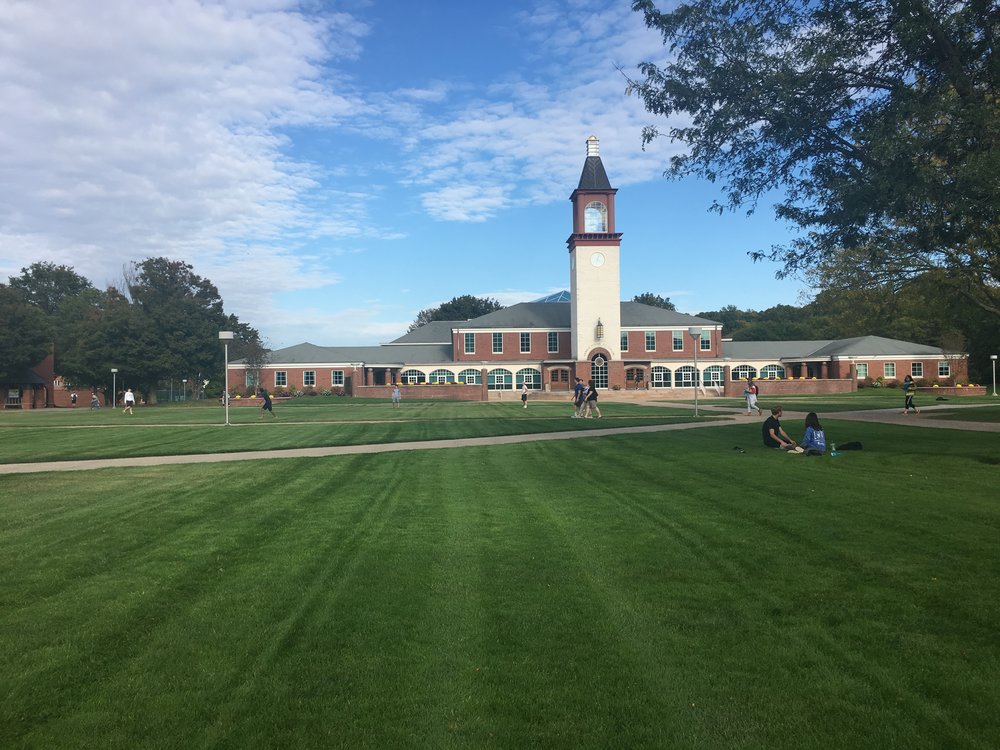
By Ayah Galal
Devastating. Horrific. Shocking. These are some of the words members of the Quinnipiac community used to describe their reaction to the series of events that took place in Charlottesville, Virginia over the summer.
Hundreds of white nationalists gathered on the University of Virginia campus to protest the removal of a confederate statue on Friday, Aug. 11. They held torches and chanted slogans like “Jews will not replace us” and “blood and soil.”
“I was actually really shocked,” said Mazel Genfi, president of the Quinnipiac chapter of the National Association for the Advancement of Colored People (NAACP). “It was a moment of disbelief but then not surprised actually. I guess the country that we live in people actually feel comfortable to do things like that.”
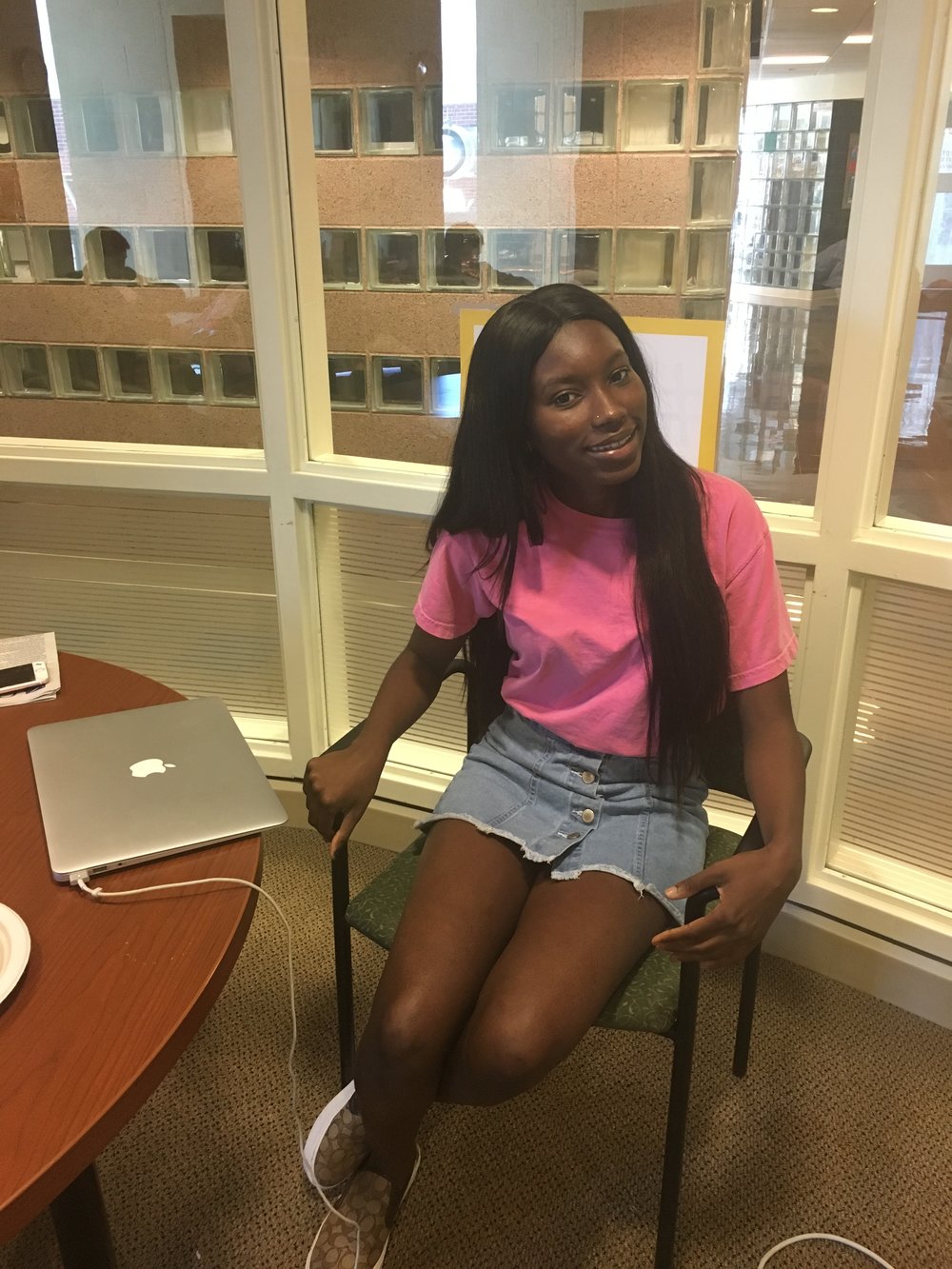
Mazel Genfi, QU NAACP President
By the next morning, counter protesters clashed with protesters and events took a violent turn. A white supremacist drove his car into a crowd of counter-protesters and killed 32-year-old Heather Heyer, who lived in Charlottesville.
The series of events drew widespread attention across the nation and sparked conversation about America’s current racial climate.
Some activists, pundits and universities responded to the incident quickly, saying more conversations about white supremacy, racism and xenophobia need to occur.
Others argued universities should prioritize safety over freedom of expression. Racist incidents have certainly marred Quinnipiac over the years. It has been nearly three months now since the events in Charlottesville. How did Quinnipiac respond? Are conversations on race still happening? Should the university be doing more to address race relations?
Quinnipiac responds
Ten days after the Charlottesville incident, Quinnipiac Vice President and Provost Dr. Mark Thompson sent a memo to the university community.
In the email sent out on Aug. 21, he wrote, “The violence, hatred, bigotry and intolerance demonstrated by white supremacist and neo-Nazi groups in Charlottesville have no place in our world and certainly have no place within our university community. Acts of violence and hatred run counter to our values as a community, and each one of us has a responsibility to ensure that these despicable types of behavior do not occur here.”
He added that students will have the opportunity to participate in social justice and inclusion-related events throughout the year to deepen their “understanding and ability to learn from one another about various aspects of the world in which we live.”
A few days later Quinnipiac President John Lahey addressed the addressed the class of 2021. Each year Lahey welcomes the incoming freshman class during “Welcome Weekend” right before the semester starts. While President Lahey tends to avoid politics during his speeches and statements, this time it was different. He was quick to condemn the hatred and bigotry that was present in Charlottesville.
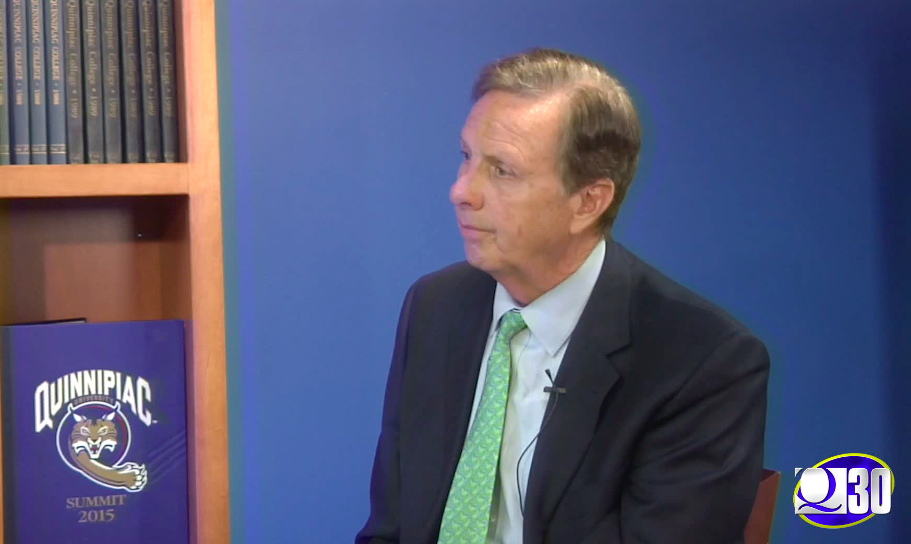
President Lahey discusses Charlottesville during an interview with Q30 Television
“I must say in light of recent events in Charlottesville it saddens me that in 2017 we still have to publicly and unequivocally condemn and state so clearly how unacceptable the views of white supremacists, Ku Klux Klan, neo-nazis [are]. Those views are simply not welcome here on the Quinnipiac campus,” President Lahey said to the freshman class. “Any behavior associated with any of these despicable kinds of beliefs and activities will not be tolerated on this campus.”
While President Lahey doesn’t consider what he said to be political, many were taken back by how direct and passionate his response was. In an interview with Q30 Television in September, President Lahey said he was “a little surprised by the reaction.” He thinks it’s because of the extent to which he discussed the incident and believes his address was “well-received.”
As students and faculty began settling in for the new semester, the Quinnipiac Center for Religion held an event titled “A Conversation on Charlottesville” on Sept. 5. The event was intended be an open forum for members of the Quinnipiac community to discuss their feelings and reactions to Charlottesville.
The incident especially hit home for Executive Director of University Religious Life Father Jordan Lenaghan. Lenaghan was a former Catholic chaplain at the University of Virginia.
“When I saw images, when I saw media coverage, when I saw news reports, when I saw photographs of places where I hung out with students, where I had worked, it hit me on a very visceral level,” Lenaghan, who helped organize the event said. “I have a job that involves words and I didn’t have words for what I saw.”
Breaking down President Trump’s response
During difficult times, presidents of the United States traditionally try to unite the nation. But at a moment where many Americans already felt divided, President Trump’s words did little to bring together the nation.
At a press conference in Trump Tower shortly after the incident, President Trump said, “I think there is blame on both sides.” Many at Quinnipiac were frustrated that he compared the violence perpetuated by white supremacists with the violence committed by counter protesters.
“I honestly believe President Trump is an absolute idiot,” Genfi said. “For him to say that says a lot about who he is and what he represents – which is basically white supremacy whether he likes it or not.”
But others at Quinnipiac did not consider his response problematic.
“He should have prefaced what he said by saying white supremacists have no place in this country,” Jeremy Wiss, President of the Quinnipiac College Republicans said. “But at the same time, both sides displayed some sort of hatred and violence; both sides showed the bad side of humanity.”
Wiss is Jewish and said the incident hit home because his great-grandparents fled persecution in Germany and Poland. While he says the situation was upsetting, Wiss believes Confederate statues should stay up so that history is not erased.
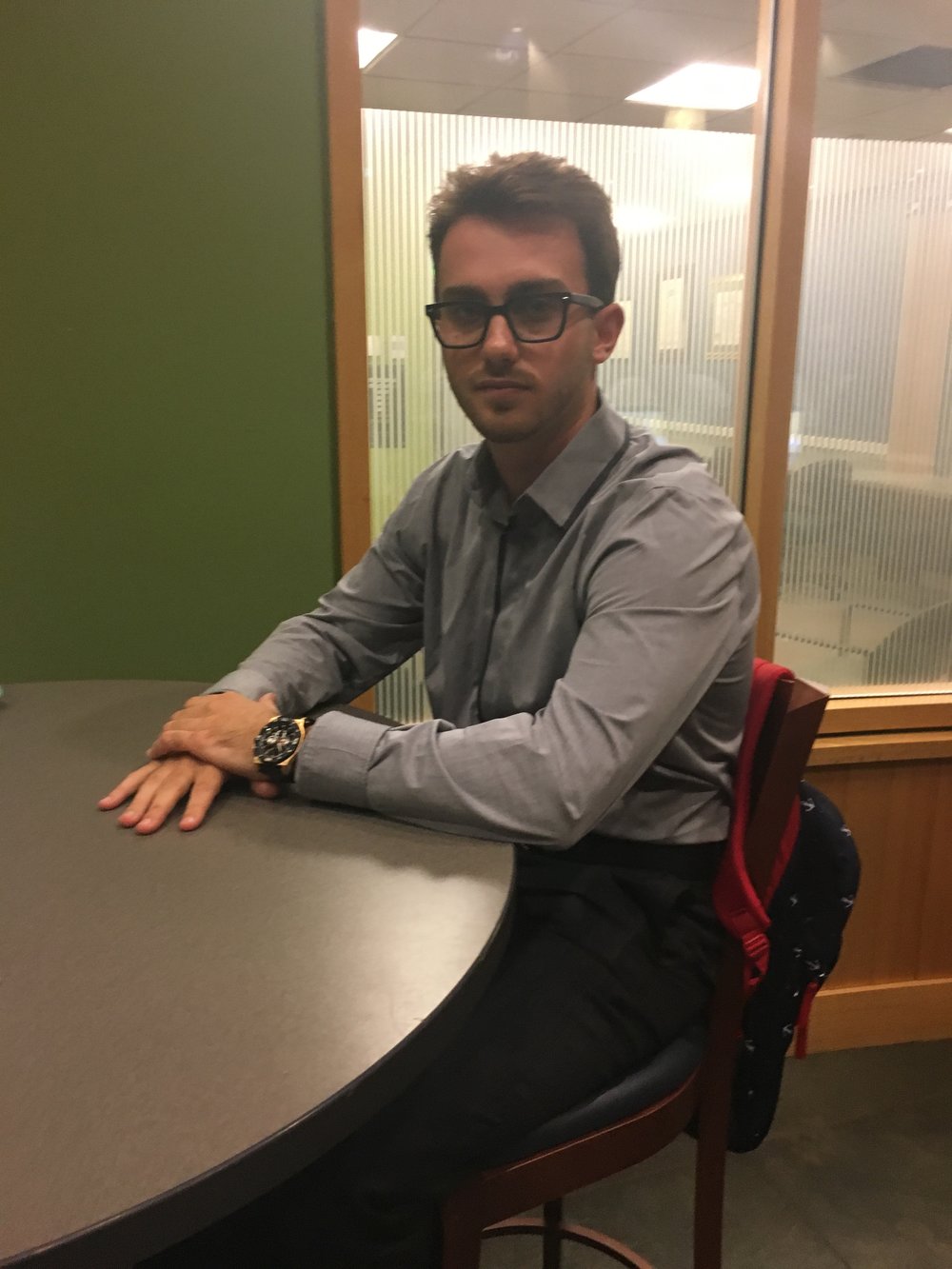
Jeremy Wiss, President of Quinnipiac College Republicans
“I can see why they continue to perpetuate issues because it is a big deal,” Wiss said.
Is hate speech free speech?
The national conversation surrounding freedom of speech intensified after white nationalists chanted slogans like “white lives matter” and “you will not replace us,” at the Unite the Right rally in Charlottesville.
But is hate speech actually protected under the First Amendment? The answer is yes.
“A lot of people think that hate speech is given no First Amendment protection,” Kearston Wesner, assistant professor of media studies said.
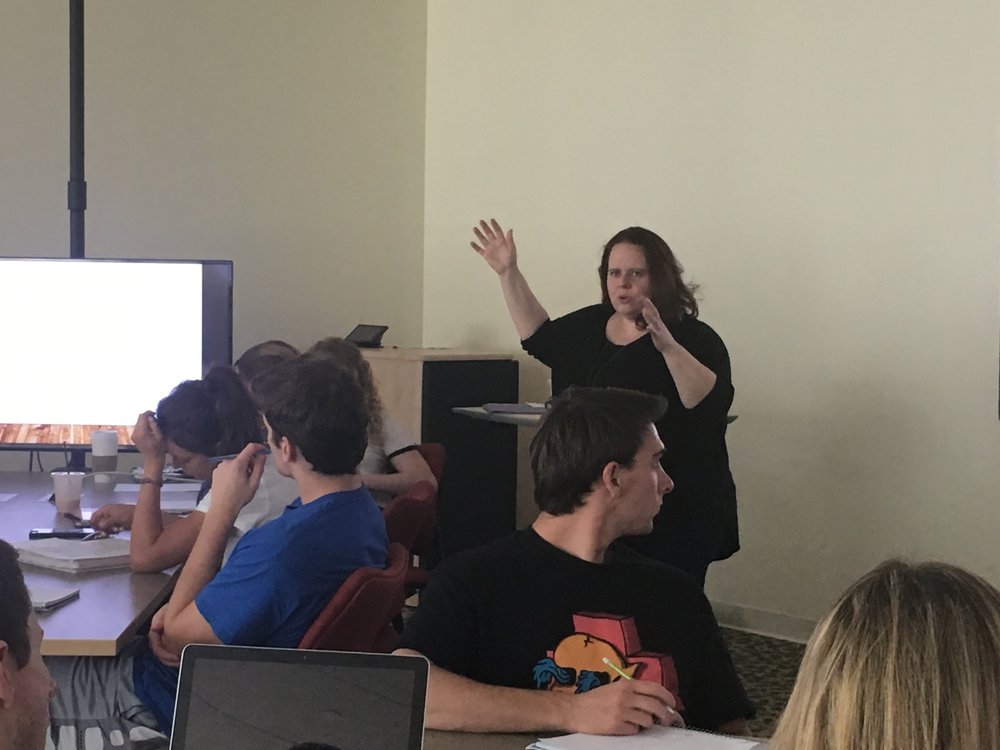
Kearston Wesner teaching a Communications Law and Policy course
Political speech especially enjoys careful protection under the First Amendment. Hate speech is difficult to define and banning speech because some view it as hate speech would be unconstitutional.
“If we start going around banning speech we dislike, usually what happens is the law that we build … tends to be applied in a broader sense against the people we were initially hoping to protect,” Wesner, who teaches Communications Law and Policy, said.
There is an exception, however. If hate speech contains incitement – an imminent threat of violence – that speech is not protected by the First Amendment.
Additionally, private universities can restrict speech. For example, Quinnipiac could choose to not allow controversial speakers like Milo Yiannopoulos or Richard Spencer on campus.
“Private universities can build their own rules and they can restrict speech how they want to,” Wesner added.
While the chances of extremely controversial speakers coming to Quinnipiac are not high, Wesner said, “It gets a lot greyer how much the university could get in and restrict that [speech] because it has a lot to do with whether it’s a university sponsored organization or an independent organization.”
When asked how Quinnipiac would respond if a student organization on campus wanted to bring a controversial speaker like Richard Spencer or Milo Yiannopoulos to speak, administration did not answer.
Confronting hate
Even before the Charlottesville incident in August, students and faculty have often discussed concerns related to race and diversity at Quinnipiac.
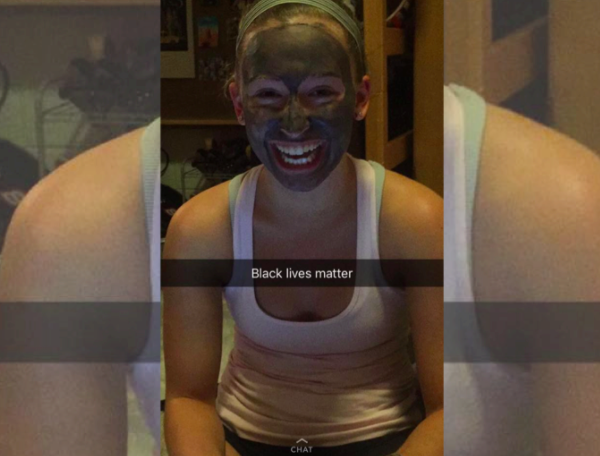
A racially insensitive Snapchat taken by a former Quinnipiac student
In September 2016, a Quinnipiac student posted a racially insensitive photograph and caption mocking the Black Lives Matter movement to Snapchat. The photograph went viral and sparked outrage not just at Quinnipiac, but in other parts of the country as well after large outlets like the New York Daily News picked up the story.
Other incidents such as swastika graffiti, caricatures of of people’s racial identity and use of derogatory terms have plagued Quinnipiac. Student Affairs takes these incidents seriously and has an established a “Bias, Harassment and Discrimination Policy” in the Quinnipiac Undergraduate Student Handbook.
“I would say the majority of the incidents hands down are in the first-year areas without a doubt,” Megan Buda, Director of Student Conduct said. “Traditionally if a student is found responsible for a violation of our bias-related policy there’s some form of removal, whether that’s from housing or separation from the institution.”
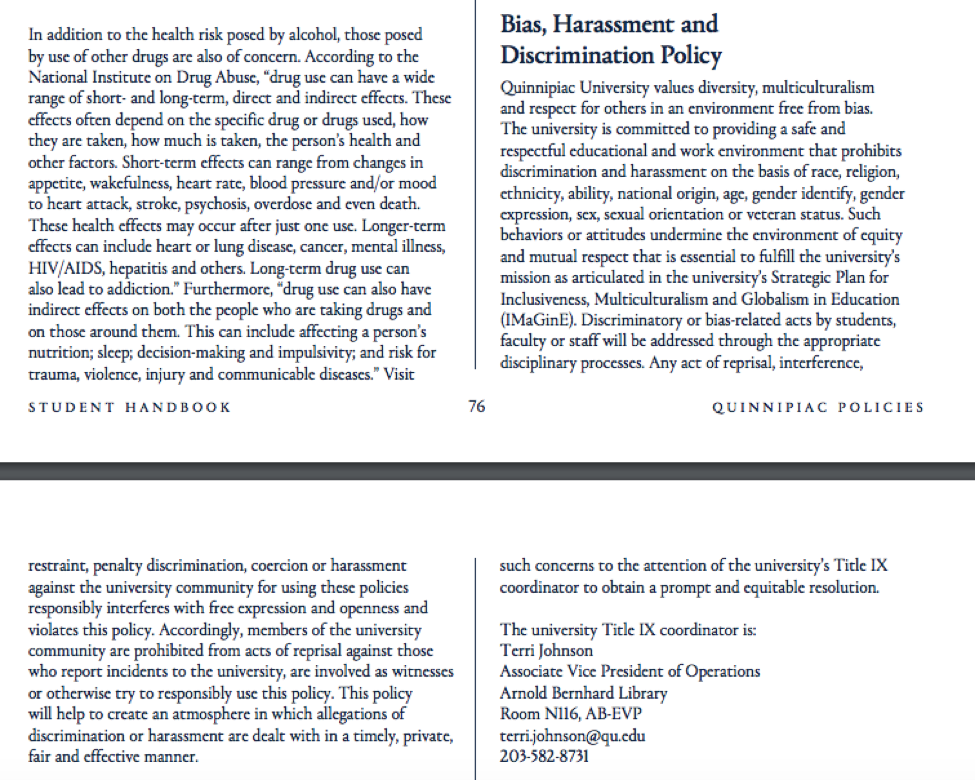
The Bias, Harassment and Discrimination Policy in the Undergraduate Student Handbook
The most common type of bias-related incident at Quinnipiac is offensive graffiti, Buda added. While displaying a Confederate flag is not a policy violation, Student Affairs understands that such a display could offend some people on campus, and tries to have constructive conversations with students who choose to do so.
Hate crimes are defined differently from bias-related incidents and the standard for a hate crime is higher since it’s defined criminally.
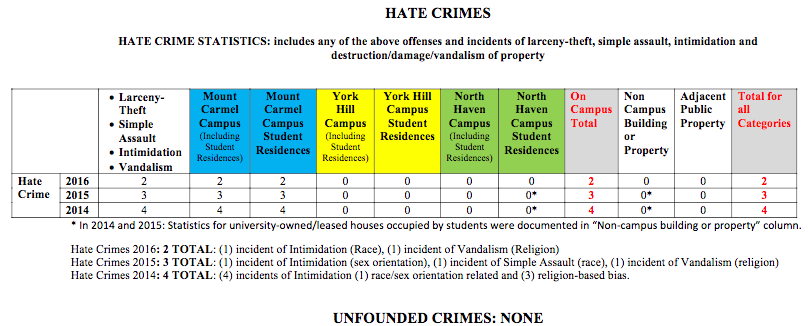
Screenshot of the Quinnipiac Annual Security report
According to Quinnipiac’s Annual Security Report, there were two hate crimes in 2016, three hate crimes in 2015 and four hate crimes in 2014. The report does not specify the nature of the incidents.
In June 2017, the Connecticut state legislature passed one of the strongest hate-crime bills in the nation. Punishment for hate crimes in the state once was a misdemeanor but the new law treats hate crimes as a felony.
While the Ku Klux Klan has had a presence within the state of Connecticut, the threat of its extreme beliefs is not high, according to Andy Friedland, Assistant Regional Director for the Connecticut Anti-Defamation League.
“Often these days we’ll see an individual print-off flyers from the KKK website, leading people to think there is an active branch of the Klan in their town, which is not true in the state of Connecticut today,” Friedland said.
What is Quinnipiac doing to address race relations on campus?
Especially after the Snapchat incident at Quinnipiac, departments ranging from Student Affairs to Cultural and Global Engagement have been organizing discussions, lectures and even Netflix series screenings to address topics related to race and diversity.
Quinnipiac Chief Diversity Officer Diane Ariza says that race-related incidents like Charlottesville have stirred up a lot of conversation.
“I think that’s healthy because it’s making us not too comfortable of where we’re at in the world,” Ariza said.
In September 2013 the Inclusion, Multiculturalism, and Globalism in Education (IMaGinE) strategic plan was created to help Quinnipiac become “a more inclusive, multicultural and diverse campus community.”
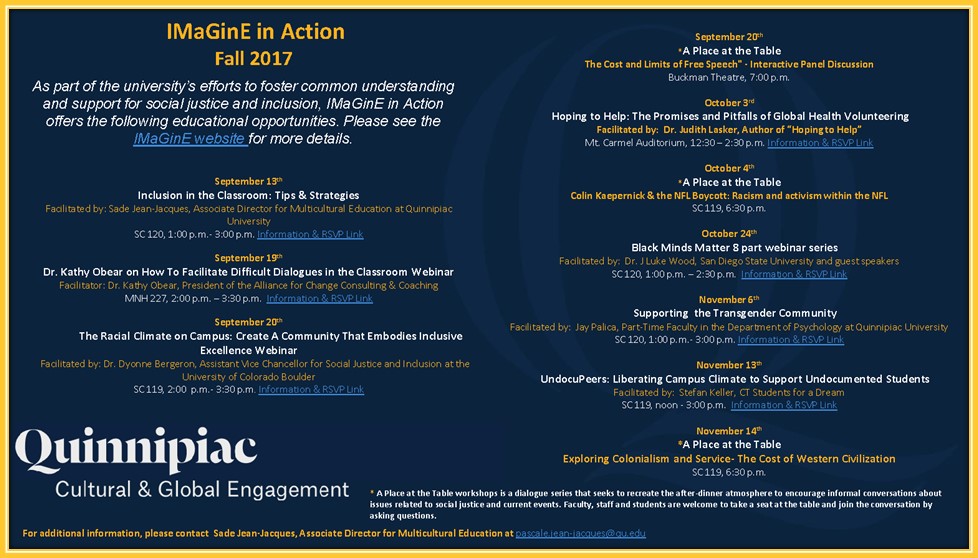
Some IMaGinE events planned for the Fall semester
Ariza, along with the help of the IMaGinE Advisory Board, organizes events that foster discussion of diversity in the Quinnipiac community. Events include “A Place at the Table” and “Circle of Perspectives” discussions.
A Place at the Table is a dialogue series that seeks to recreate an after-dinner atmosphere to encourage informal conversations about issues related to social justice and current events. Circle of Perspectives is a series of nonpartisan group discussions involving critical thinking about diversity and social inequalities.
“I think educating is what we’ve decided our department has decided to do with the social issues,” Ariza said.
Student Affairs is also taking a similar approach. Megan Buda and Mark DeVilbiss, co-chairs of the Student Affairs Diversity and Inclusion Committee, say the committee is dedicated to celebrating diversity and facilitating conversations on race and inclusion. The committee has representation from the Department of Cultural and Global Engagement, Residential Life, Counseling Services, Student Government Association Religious Life and Community Service.
The Diversity and Inclusion Committee started hosting screenings of episodes from the Netflix series “Dear White People,” followed by a discussion.
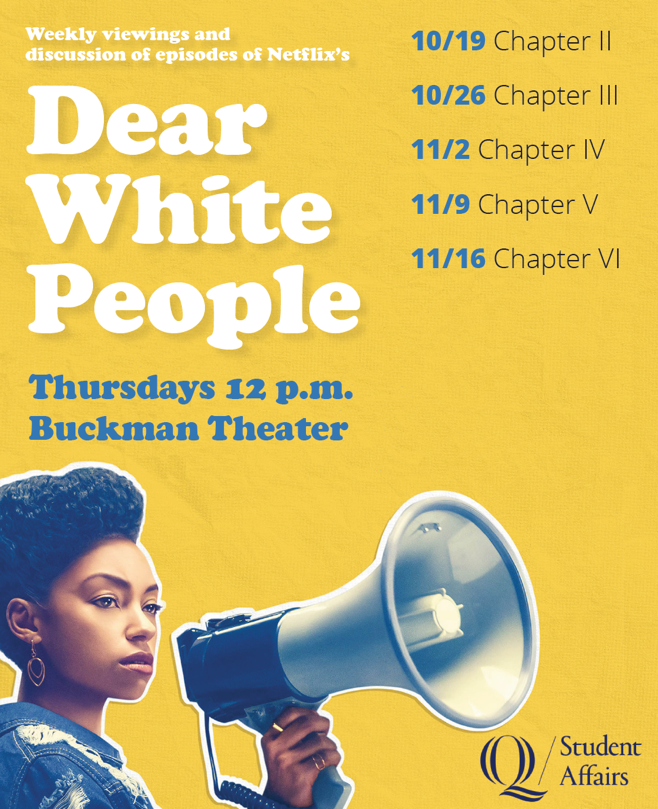
Dates Student Affairs is screening episodes of “Dear White People”
“It fueled a very thorough discussion of everything, from what it means to be white to what it means to be a person of color on a white campus,” Buda said.
The committee plans to show more episodes of the series during the semester in hopes of facilitating more conversations.
“We want to be able to help people understand and know how to talk about issues of inclusion and diversity, whether that’s religious or racial or ethnic,” Director of Residential Life Mark DeVilbiss said. “I’m proud to be part of the efforts that are happening campus-wide whether it’s in the classroom or something DCGE is doing, or any group on campus.”
Dr. Thompson also announced plans for establishing a new curriculum with more diversity-related courses. Two intercultural responsibility and citizenship courses will be mandatory for future students.
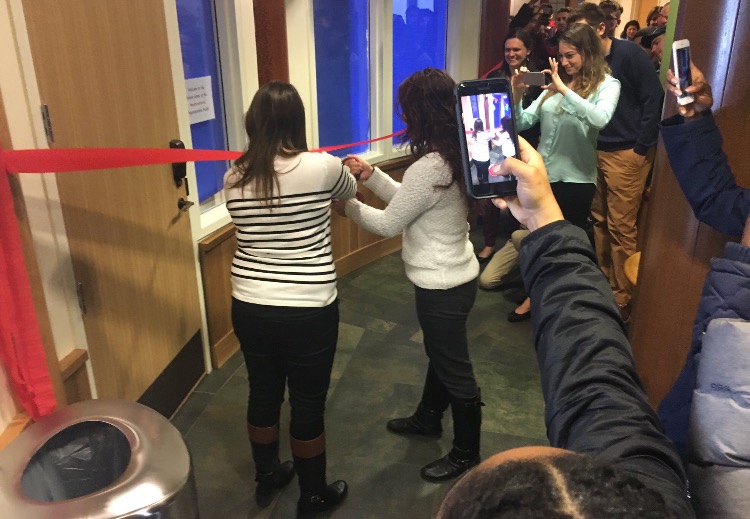
Opening ceremony of the multicultural suite in the Carl Hansen Student Center
Last semester, the Multicultural Suite – a space for culture and identity based organizations – opened in the Carl Hansen Student Center.
Quinnipiac is also hosting a one-day conference on social justice and civic engagement titled “Creating Space: Solidarity, Dialogue, Social Justice, Opportunity.” Director of Community Service Vincent Contrucci says the purpose of the conference is to provide students from across New England with a space for dialogue surrounding social justice related issues.
Additionally, 21 percent of the current freshman class identify as students of color, which makes the first-year class the most diverse in Quinnipiac history.
What still needs to be done
Last semester, the Office of the Executive Vice President and Provost and the Department of Cultural and Global Engagement engaged MRW Consulting Group International LLC to help with an assessment of Quinnipiac’s campus climate and help the university identify ways to improve the attitudes, standards and behaviors of the university community.

A representative from MRW Consulting Group discusses findings from the campus climate study during a university town hall.
MRW held focus groups with 134 students over the course of the Spring 2017 semester. The firm interviewed 15 affinity groups including the Quinnipiac NAACP, Latino Cultural Society, Gender Sexuality Alliance and Greek Life. The consulting firm compiled a 51-page report and found areas where Quinnipiac can improve its campus climate, as well as suggestions on how to do so.
Thompson organized a town hall-style event in the Mount Carmel Auditorium on Oct. 3 during which MRW Consulting Group shared the findings from the campus climate study, suggested courses of action and answered questions from the audience.
The report acknowledged the progress the university has been making, but also pointed out areas where there could be more improvement.
The study found that many students felt that more could be done to recruit higher numbers of faculty, staff and students of color. The study also found that it would be helpful to train faculty members to be more comfortable having difficult conversations they may need to have with students.
Many minorities in the focus groups described how uncomfortable they are when asked to represent an entire group in classes. The study also found that Quinnipiac can improve the campus climate by increasing the number of minority Greek organizations on campus.
The firm also suggested that Quinnipiac should “leverage campus commitment by getting everyone involved in solutions.” Many students from the focus groups also emphasized the need to integrate diversity, inclusion and multiculturalism into the core curriculum.
Quinnipiac administrators recognize lots of work needs to be done and they plan to continue to facilitating conversations on diversity and race in an effort to make Quinnipiac more inclusive.
But some students think more can be done to address race relations on campus and make minorities feel more comfortable at Quinnipiac.
“In my honest opinion, I do see that they’re trying, but not trying hard enough,” said Genfi, the QU NAACP president. “I feel like if they were trying hard enough, certain things wouldn’t have happened.”
She believes the university is taking the right steps, but that Quinnipiac should be more proactive. Genfi also thinks that students at Quinnipiac are becoming more comfortable discussing race than they were four years ago.
“People are more open to being educated and stepping out of that Quinnipiac bubble, whereas four years ago that would have never had happened,” Genfi added.